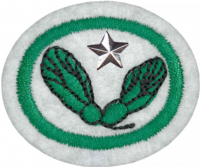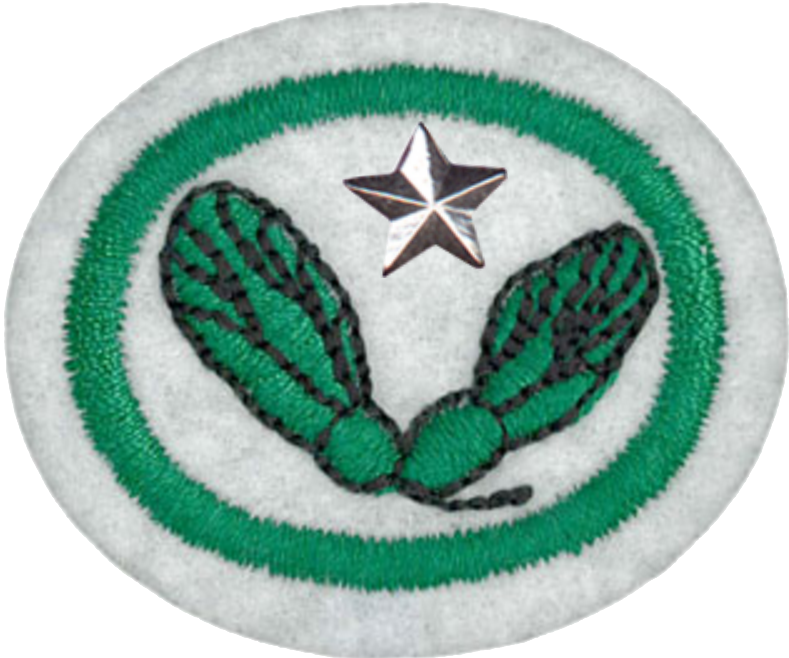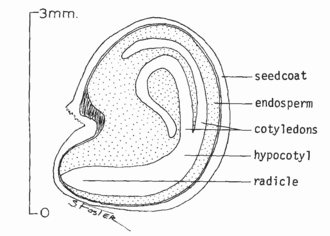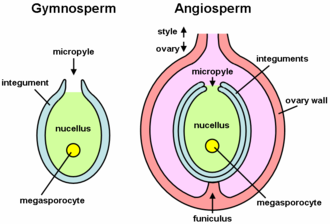Difference between revisions of "AY Honors/Seeds - Advanced/Answer Key"
m (23 revisions: import with history from WB) |
m (- Category of AYHAB) |
||
| (19 intermediate revisions by 3 users not shown) | |||
| Line 1: | Line 1: | ||
| − | {{ | + | {{HonorSubpage}} |
| − | + | <section begin="Body" /> | |
| − | {{ | + | {{ansreq|page={{#titleparts:{{PAGENAME}}|2|1}}|num=1}} |
| + | <noinclude><translate><!--T:16--> | ||
| + | </noinclude> | ||
| + | <!-- 1. Have the Seeds honor. --> | ||
| + | {{honor_prerequisite|honor=Seeds}} | ||
| − | ==2. Identify from drawings and know the purpose of each of the following parts of a seed: endosperm, radicle, plumule, micropyle. | + | <!--T:17--> |
| + | <noinclude></translate></noinclude> | ||
| + | {{CloseReq}} <!-- 1 --> | ||
| + | {{ansreq|page={{#titleparts:{{PAGENAME}}|2|1}}|num=2}} | ||
| + | <noinclude><translate><!--T:18--> | ||
| + | </noinclude> | ||
| + | <!-- 2. Identify from drawings and know the purpose of each of the following parts of a seed: endosperm, radicle, plumule, micropyle. --> | ||
[[Image:Lycium barbarum seed.png|thumb|300px|Diagram showing the endosperm and radicle.]] | [[Image:Lycium barbarum seed.png|thumb|300px|Diagram showing the endosperm and radicle.]] | ||
[[Image:Ovule.png|thumb|300px|Plant ovules: Gymnosperm ovule on left, angiosperm ovule (inside ovary) on right]] | [[Image:Ovule.png|thumb|300px|Plant ovules: Gymnosperm ovule on left, angiosperm ovule (inside ovary) on right]] | ||
;Endosperm: Endosperm is the tissue produced in the seeds of most flowering plants around the time of fertilization. It surrounds the embryo and provides nutrition in the form of starch, though it can also contain oils and protein. | ;Endosperm: Endosperm is the tissue produced in the seeds of most flowering plants around the time of fertilization. It surrounds the embryo and provides nutrition in the form of starch, though it can also contain oils and protein. | ||
;Radicle: The radicle is the first part of a seedling (a growing plant embryo) to emerge from the seed during the process of germination. The radicle is the embryonic root of the plant, and grows downward in the soil. | ;Radicle: The radicle is the first part of a seedling (a growing plant embryo) to emerge from the seed during the process of germination. The radicle is the embryonic root of the plant, and grows downward in the soil. | ||
| − | ;Plumule: The plumule is the embryonic shoot. | + | ;Plumule: The plumule is the embryonic shoot. It is the precursor to the stem and leaves of the plant. |
| − | ;Micropyle: The micropyle is an opening in a plant's ovule (the structure that gives rise to and contains the female reproductive cells). | + | <!--T:3--> |
| + | ;Micropyle: The micropyle is an opening in a plant's ovule (the structure that gives rise to and contains the female reproductive cells). The micropyle opening allows the pollen tube to enter the ovule for fertilization. In gymnosperms (e.g. conifers), the pollen itself is drawn into the ovule and the micropyle opening closes after pollination. During germination, the seedling's radicle emerges through the micropyle. | ||
<br style="clear:both"> | <br style="clear:both"> | ||
| − | ==3. Know several differences between a monocotyledon seed and a dicotyledon seed, and give three examples of each. | + | <!--T:19--> |
| + | <noinclude></translate></noinclude> | ||
| + | {{CloseReq}} <!-- 2 --> | ||
| + | {{ansreq|page={{#titleparts:{{PAGENAME}}|2|1}}|num=3}} | ||
| + | <noinclude><translate><!--T:20--> | ||
| + | </noinclude> | ||
| + | <!-- 3. Know several differences between a monocotyledon seed and a dicotyledon seed, and give three examples of each. --> | ||
[[Image:Monocot vs dicot crop Pengo.jpg|thumb|300px|Comparison of a monocot (left) and dicot (right) sprouting]] | [[Image:Monocot vs dicot crop Pengo.jpg|thumb|300px|Comparison of a monocot (left) and dicot (right) sprouting]] | ||
| − | In monocotyledons (or simply ''monocots''), the seed embryo has one cotyledon while the embryo of the dicotyledon (or ''dicot'') has two. | + | In monocotyledons (or simply ''monocots''), the seed embryo has one cotyledon while the embryo of the dicotyledon (or ''dicot'') has two. The major leaf veins in a monoct are parallel, but they are branched in a dicot. The flower parts (petals, sepals, etc.) in monocots are multiples of three while in dicots are multiples of four or five. |
| − | ===Monocots=== | + | ===Monocots=== <!--T:5--> |
*Corn | *Corn | ||
*Grasses (such as wheat, rye, barley, etc.) | *Grasses (such as wheat, rye, barley, etc.) | ||
| Line 30: | Line 47: | ||
<br style="clear:both"> | <br style="clear:both"> | ||
| − | ==4. Explain the purpose and use of a "rag doll" seed tester. Use it to test the germination of 100 seeds of a wild plant and 100 seeds of a domestic plant. Report the results of each test. | + | <!--T:21--> |
| − | {{: | + | <noinclude></translate></noinclude> |
| + | {{CloseReq}} <!-- 3 --> | ||
| + | {{ansreq|page={{#titleparts:{{PAGENAME}}|2|1}}|num=4}} | ||
| + | <noinclude><translate><!--T:22--> | ||
| + | </noinclude> | ||
| + | <!-- 4. Explain the purpose and use of a "rag doll" seed tester. Use it to test the germination of 100 seeds of a wild plant and 100 seeds of a domestic plant. Report the results of each test. --> | ||
| + | {{:AY Honors/Germination testing}} | ||
| − | ==5. How does a seed differ from a spore? | + | <!--T:23--> |
| + | <noinclude></translate></noinclude> | ||
| + | {{CloseReq}} <!-- 4 --> | ||
| + | {{ansreq|page={{#titleparts:{{PAGENAME}}|2|1}}|num=5}} | ||
| + | <noinclude><translate><!--T:24--> | ||
| + | </noinclude> | ||
| + | <!-- 5. How does a seed differ from a spore? --> | ||
A chief difference between spores and seeds as dispersal units is that spores have very little stored food resources compared with seeds, and thus require more favorable conditions in order to successfully germinate. Seeds, therefore, are more resistant to harsh conditions and require less energy to start cell division. Spores are usually produced in large numbers to increase the chance of a spore surviving. | A chief difference between spores and seeds as dispersal units is that spores have very little stored food resources compared with seeds, and thus require more favorable conditions in order to successfully germinate. Seeds, therefore, are more resistant to harsh conditions and require less energy to start cell division. Spores are usually produced in large numbers to increase the chance of a spore surviving. | ||
| − | ==6. Write or tell orally two spiritual lessons we may learn from seeds. You will find help in Christ's Object Lessons by Ellen G. White, pages 33 to 89. | + | <!--T:25--> |
| − | You can | + | <noinclude></translate></noinclude> |
| + | {{CloseReq}} <!-- 5 --> | ||
| + | {{ansreq|page={{#titleparts:{{PAGENAME}}|2|1}}|num=6}} | ||
| + | <noinclude><translate><!--T:26--> | ||
| + | </noinclude> | ||
| + | <!-- 6. Write or tell orally two spiritual lessons we may learn from seeds. You will find help in Christ's Object Lessons by Ellen G. White, pages 33 to 89. --> | ||
| + | You can [http://egwdatabase.whiteestate.org/nxt/gateway.dll?f=templates$fn=default.htm$vid=default read this text online] or you can get a copy of the book at [http://www.adventistbookcenter.com/Detail.tpl?sku=0828015406 The Adventist Book Center]. | ||
| − | This text is a discourse on the parable of the sower as found in Matthew 13. | + | <!--T:9--> |
| + | This text is a discourse on the parable of the sower as found in Matthew 13. Ellen White illustrates several spiritual lessons based on this parable. | ||
| − | ==7. Make a collection of 60 different kinds of seeds, of which only 15 may be collected from commercial seed packages, the other 45 you are to collect yourself. Label each kind as follows: seed name, date collected, location collected, and collector’s name. | + | <!--T:27--> |
| + | <noinclude></translate></noinclude> | ||
| + | {{CloseReq}} <!-- 6 --> | ||
| + | {{ansreq|page={{#titleparts:{{PAGENAME}}|2|1}}|num=7}} | ||
| + | <noinclude><translate><!--T:28--> | ||
| + | </noinclude> | ||
| + | <!-- 7. Make a collection of 60 different kinds of seeds, of which only 15 may be collected from commercial seed packages, the other 45 you are to collect yourself. Label each kind as follows: seed name, date collected, location collected, and collector’s name. --> | ||
| − | {{: | + | <!--T:11--> |
| + | {{:AY Honors/Seeds/Seed collection}} | ||
| − | ==8. Have in your collection four kinds of seeds from each of two families of plants, showing the similarity between the seeds of plants in any one family. | + | <!--T:29--> |
| − | The two families of plants are the ''moncots'' and the ''dicots''. | + | <noinclude></translate></noinclude> |
| + | {{CloseReq}} <!-- 7 --> | ||
| + | {{ansreq|page={{#titleparts:{{PAGENAME}}|2|1}}|num=8}} | ||
| + | <noinclude><translate><!--T:30--> | ||
| + | </noinclude> | ||
| + | <!-- 8. Have in your collection four kinds of seeds from each of two families of plants, showing the similarity between the seeds of plants in any one family. --> | ||
| + | The two families of plants are the ''moncots'' and the ''dicots''. To see the difference, cut a corn kernel and a bean in half. The corn seed will be difficult to divide, but the bean will almost divide itself in half at the boundary between the two cotyledons. | ||
| − | ==References== | + | <!--T:31--> |
| − | + | <noinclude></translate></noinclude> | |
| − | + | {{CloseReq}} <!-- 8 --> | |
| + | <noinclude><translate></noinclude> | ||
| + | ==References== <!--T:13--> | ||
| + | <noinclude></translate></noinclude> | ||
| + | {{CloseHonorPage}} | ||
Latest revision as of 21:37, 14 July 2022
1
For tips and instruction see Seeds.
2
- Endosperm
- Endosperm is the tissue produced in the seeds of most flowering plants around the time of fertilization. It surrounds the embryo and provides nutrition in the form of starch, though it can also contain oils and protein.
- Radicle
- The radicle is the first part of a seedling (a growing plant embryo) to emerge from the seed during the process of germination. The radicle is the embryonic root of the plant, and grows downward in the soil.
- Plumule
- The plumule is the embryonic shoot. It is the precursor to the stem and leaves of the plant.
- Micropyle
- The micropyle is an opening in a plant's ovule (the structure that gives rise to and contains the female reproductive cells). The micropyle opening allows the pollen tube to enter the ovule for fertilization. In gymnosperms (e.g. conifers), the pollen itself is drawn into the ovule and the micropyle opening closes after pollination. During germination, the seedling's radicle emerges through the micropyle.
3
In monocotyledons (or simply monocots), the seed embryo has one cotyledon while the embryo of the dicotyledon (or dicot) has two. The major leaf veins in a monoct are parallel, but they are branched in a dicot. The flower parts (petals, sepals, etc.) in monocots are multiples of three while in dicots are multiples of four or five.
Monocots
- Corn
- Grasses (such as wheat, rye, barley, etc.)
- Lilies
- Onions, garlic
Dicots
- Roses
- Asters
- Nightshades (tomatoes, potatoes, etc.)
- Squash, pumpkin
- Beans
4
The purpose of a "rag doll" test is to determine the percentage of seeds in a given lot that will successfully germinate. This information can then used for calculating seeding rates.
A simple way to get an idea of the actual field germination prior to planting is to conduct a “ragdoll” test. A “ragdoll” consists of a rolled tube of moistened paper containing the seeds to be tested for germination, placed in plastic bag and stored in a warm place for several days. seedlings are counted as they germinate and are removed, giving the percentage of actual germination.
To conduct a ragdoll test, moisten a brown paper hand towel and squeeze out as much excess water as possible. Do not use a "soft" paper towel as are typically found in a home kitchen - seeds can send roots and tops through these complicating the count. Excess water in the towel will cut off oxygen and ruin the test.
Spread the paper towel out on a flat surface, count out 100 seeds and place them in a line (diagonally works well) across the towel. Roll the towel up and place it in a plastic bag. Seal the bag, and place it in a warm place, such as on the top of a refrigerator. A temperature of 30°C![]() is ideal.
is ideal.
After four days, remove the towel from the plastic bag, unroll it, and count and remove any seeds that have germinated. Roll the towel back up, return it to the plastic bag, reseal, and return it to the top of the refrigerator.
After three or four more days, repeat the count. The total number of seeds from both counts will equal the germination rate, assuming 100 seeds were used. If a different number of seeds were used, you can calculate the germination rate as follows:
[math]\displaystyle{ Germination\ Rate = \frac{Germinated\ Seeds}{Germinated\ Seeds + Ungerminated\ Seeds} \times 100 }[/math]
5
A chief difference between spores and seeds as dispersal units is that spores have very little stored food resources compared with seeds, and thus require more favorable conditions in order to successfully germinate. Seeds, therefore, are more resistant to harsh conditions and require less energy to start cell division. Spores are usually produced in large numbers to increase the chance of a spore surviving.
6
You can read this text online or you can get a copy of the book at The Adventist Book Center.
This text is a discourse on the parable of the sower as found in Matthew 13. Ellen White illustrates several spiritual lessons based on this parable.
7
Seeds are all around you. You can find them in many fruits, such as apples, oranges, pears, grapefruit, tangerines, strawberries, lemons. They are also present in many vegetables, such as cucumber, squash, pumpkin, corn (use popcorn for your collection), and beans of all varieties. Take a stroll through the produce section of a grocery store and buy some of these foods. It is especially fun to try new and unusual fruits and vegetables.
Flowers also make seeds, so you can collect seeds from flowers that you already may have growing in your flower bed or someone else's flower beds (with their permission).
You can also collect various seeds in the wild, including grass seeds, milkweed, acorns (and other nuts), clover, goldenrod, etc.
Once you have exhausted these sources, go to the seed section of a store or a nursery. This should be reserved as a last resort.
8
The two families of plants are the moncots and the dicots. To see the difference, cut a corn kernel and a bean in half. The corn seed will be difficult to divide, but the bean will almost divide itself in half at the boundary between the two cotyledons.





